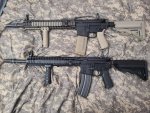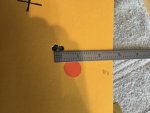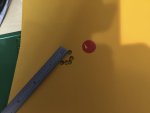It may become the 41 mag of rifle cartridges, but that’s ok, reloading gives you much more options. I actually like the 41, lol.Aero, JP, PSA - all exiting - that's not a good sign.
Join the Hide community
Get access to live stream, lessons, the post exchange, and chat with other snipers.
Register
Download Gravity Ballistics
Get help to accurately calculate and scope your sniper rifle using real shooting data.

Install the app
How to install the app on iOS
Follow along with the video below to see how to install our site as a web app on your home screen.
Note: This feature may not be available in some browsers.
You are using an out of date browser. It may not display this or other websites correctly.
You should upgrade or use an alternative browser.
You should upgrade or use an alternative browser.
Is .224 Valkyrie going to die out?
- Thread starter ToddM
- Start date
Curious what everyone thinks the fate of the .224 Valkyrie will be between it's problematic start with the 90 grain ammo problems and now the 6 ARC being the new AR flavor of the year.
It looks like JP is getting out of the .224 Valkyrie game. They are no longer list .224 supermatch barrels as an option on their website, or as an option for any of their builds, and some retailers are blowing barrels out pretty cheap.
I personally grew to love it. My expectations are a little more reasonable though. I only routinely shoot 100y to 800y now-a-days and I shoot it a lot so good barrel life and long range capability has kept this one alive for me. I mainly shoot 80gr ELDM, 88gr ELDM, 85.5gr Berger, and 90gr SMK. I reload so I’ve come out on top when it comes to cost. I shoot it exclusively in a Bighorn Origin bolt action setup with HS Precision DBM and it does well for me. Even on smaller to mediumish game it’s done well with the right bullet. I went through the growing pains with improper twist rates and chambers until I finally settled on the right combo for me. The 6arc has no appeal to me, I shoot a 6GT and 6.5 Creedmoor then skip straight to 300 WSM if I need large game capability. I still shoot a grendel but with 100gr ELDM, 107gr Sierra TMK and 108gr Lapua Scenars exclusively and keep the heavier 6.5’s for the Creedmoor.
here’s a couple groups with my setup.
Attachments
-
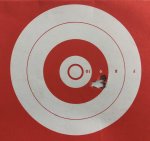 37E9EA51-10D4-4210-BE63-B5802633BEA2.jpeg408.7 KB · Views: 118
37E9EA51-10D4-4210-BE63-B5802633BEA2.jpeg408.7 KB · Views: 118 -
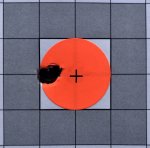 A6951066-059D-4D04-8D80-8CB1EAA7D9C5.jpeg819.6 KB · Views: 136
A6951066-059D-4D04-8D80-8CB1EAA7D9C5.jpeg819.6 KB · Views: 136 -
 3B54D129-9E28-4CE3-A15B-A00462D75D60.jpeg1 MB · Views: 133
3B54D129-9E28-4CE3-A15B-A00462D75D60.jpeg1 MB · Views: 133 -
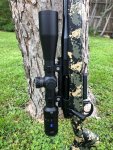 4619F5FE-B83C-42DD-957D-2E2CE9E25FAD.jpeg824.4 KB · Views: 102
4619F5FE-B83C-42DD-957D-2E2CE9E25FAD.jpeg824.4 KB · Views: 102 -
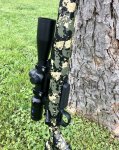 57602E5F-3271-4D69-B0AE-1C8B79180F88.jpeg1,016.8 KB · Views: 111
57602E5F-3271-4D69-B0AE-1C8B79180F88.jpeg1,016.8 KB · Views: 111 -
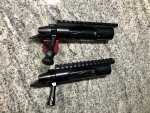 01F1D8C8-512A-4C24-BB36-C667E9DEA98B.jpeg844.6 KB · Views: 145
01F1D8C8-512A-4C24-BB36-C667E9DEA98B.jpeg844.6 KB · Views: 145 -
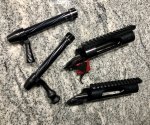 BE0AF5D5-AAE2-48E7-9DA0-FB4200CA9048.jpeg927.3 KB · Views: 114
BE0AF5D5-AAE2-48E7-9DA0-FB4200CA9048.jpeg927.3 KB · Views: 114
Last edited:
Both of mine worked well out of the gate.
The first was a 22” Shilen 6.5 twist and its a consistent hammer. I’ve made 1st round hits on P Dogs out to 750yds. Go to powders are RL 17, Win760 and BLC-2 with 90 and 95 SMKs. It also nearly matches my 6.5 Creedmoor dope to 1000. I accidentally used my creedmoor dope card with it once and it was working with 95 SMKs at 2650 FPS.
I put a second one together and went with light weight parts for hunting.
It’s not a hammer, but still sub MOA. I used an 18” BSF barrel for its weight. It’s a 7 twist and doesn’t like the 90s. The 90s average about 1 inch sometimes a touch over, I wasn’t planning on shooting 90s for this one so I wasn’t disappointed.
It does shoot the 75 grain factory TMJs into .75 MOA consistently. It shoots the Federal 60 ballistic tips between .4-.7. I built it for a day time coyote hunting rifle. It’s not close to my Shilen barreled gun when it comes to group size but still plenty good for coyotes inside 500yds.
It’s also the only thing in stock at near normal prices. I’ve been snatching up 200 rd cases of the federal 75s TMJ for $129. Picked up 7-8 cases recently.
I’m vested pretty good in this round since it came about 3.5 years ago and didn’t have the problems some other guys had so I’m riding it out. My hunting Valkyrie I don’t load for “time constraints “ and the factory federal 60s do the job just fine, I’ve never had a “Runner” yet, all DRT.
Some of you guys that are loading, try RL17 and plain ole WIN760 and see what happens.
The first was a 22” Shilen 6.5 twist and its a consistent hammer. I’ve made 1st round hits on P Dogs out to 750yds. Go to powders are RL 17, Win760 and BLC-2 with 90 and 95 SMKs. It also nearly matches my 6.5 Creedmoor dope to 1000. I accidentally used my creedmoor dope card with it once and it was working with 95 SMKs at 2650 FPS.
I put a second one together and went with light weight parts for hunting.
It’s not a hammer, but still sub MOA. I used an 18” BSF barrel for its weight. It’s a 7 twist and doesn’t like the 90s. The 90s average about 1 inch sometimes a touch over, I wasn’t planning on shooting 90s for this one so I wasn’t disappointed.
It does shoot the 75 grain factory TMJs into .75 MOA consistently. It shoots the Federal 60 ballistic tips between .4-.7. I built it for a day time coyote hunting rifle. It’s not close to my Shilen barreled gun when it comes to group size but still plenty good for coyotes inside 500yds.
It’s also the only thing in stock at near normal prices. I’ve been snatching up 200 rd cases of the federal 75s TMJ for $129. Picked up 7-8 cases recently.
I’m vested pretty good in this round since it came about 3.5 years ago and didn’t have the problems some other guys had so I’m riding it out. My hunting Valkyrie I don’t load for “time constraints “ and the factory federal 60s do the job just fine, I’ve never had a “Runner” yet, all DRT.
Some of you guys that are loading, try RL17 and plain ole WIN760 and see what happens.
I’m curious about the win 760 I have a few lbs of that.Both of mine worked well out of the gate.
The first was a 22” Shilen 6.5 twist and its a consistent hammer. I’ve made 1st round hits on P Dogs out to 750yds. Go to powders are RL 17, Win760 and BLC-2 with 90 and 95 SMKs. It also nearly matches my 6.5 Creedmoor dope to 1000. I accidentally used my creedmoor dope card with it once and it was working with 95 SMKs at 2650 FPS.
I put a second one together and went with light weight parts for hunting.
It’s not a hammer, but still sub MOA. I used an 18” BSF barrel for its weight. It’s a 7 twist and doesn’t like the 90s. The 90s average about 1 inch sometimes a touch over, I wasn’t planning on shooting 90s for this one so I wasn’t disappointed.
It does shoot the 75 grain factory TMJs into .75 MOA consistently. It shoots the Federal 60 ballistic tips between .4-.7. I built it for a day time coyote hunting rifle. It’s not close to my Shilen barreled gun when it comes to group size but still plenty good for coyotes inside 500yds.
It’s also the only thing in stock at near normal prices. I’ve been snatching up 200 rd cases of the federal 75s TMJ for $129. Picked up 7-8 cases recently.
I’m vested pretty good in this round since it came about 3.5 years ago and didn’t have the problems some other guys had so I’m riding it out. My hunting Valkyrie I don’t load for “time constraints “ and the factory federal 60s do the job just fine, I’ve never had a “Runner” yet, all DRT.
Some of you guys that are loading, try RL17 and plain ole WIN760 and see what happens.
Both of mine worked well out of the gate.
The first was a 22” Shilen 6.5 twist and its a consistent hammer. I’ve made 1st round hits on P Dogs out to 750yds. Go to powders are RL 17, Win760 and BLC-2 with 90 and 95 SMKs. It also nearly matches my 6.5 Creedmoor dope to 1000. I accidentally used my creedmoor dope card with it once and it was working with 95 SMKs at 2650 FPS.
I put a second one together and went with light weight parts for hunting.
It’s not a hammer, but still sub MOA. I used an 18” BSF barrel for its weight. It’s a 7 twist and doesn’t like the 90s. The 90s average about 1 inch sometimes a touch over, I wasn’t planning on shooting 90s for this one so I wasn’t disappointed.
It does shoot the 75 grain factory TMJs into .75 MOA consistently. It shoots the Federal 60 ballistic tips between .4-.7. I built it for a day time coyote hunting rifle. It’s not close to my Shilen barreled gun when it comes to group size but still plenty good for coyotes inside 500yds.
It’s also the only thing in stock at near normal prices. I’ve been snatching up 200 rd cases of the federal 75s TMJ for $129. Picked up 7-8 cases recently.
I’m vested pretty good in this round since it came about 3.5 years ago and didn’t have the problems some other guys had so I’m riding it out. My hunting Valkyrie I don’t load for “time constraints “ and the factory federal 60s do the job just fine, I’ve never had a “Runner” yet, all DRT.
Some of you guys that are loading, try RL17 and plain ole WIN760 and see what happens.
I just got a 1-7 Saturn barrel and upper for a AR build. I plan on this being my night hunting setup for coyotes. Some days later in the season when I expected doubles.
My brother built a Valkyrie last yr (palmetto everything basically so budget) and I'll be damned if that thing isn't an absolute tack driver. Most accurate AR I have ever seen.
If I remember correctly he shoots 90g Berger Full bores.
I saw a lot of ammo for it and a factory AR-15 chambered in it at a local gun store 2 weeks ago. They had a .300 BLK AR-15 with a PRI 6.8 mag in it, which caught my eye. I asked the sales clerk why that 6.8 mag was in there, and he mumbled something about it as if it was meant to be.
I took a look at the other AR-15 left on the shelf (everything else was of course gone), and it was an 18” .224 Valkyrie. I told him that PRI 6.8 mag belongs in the Valkyrie since that’s the parent case. “Oh.."
They had several stacks of different factory loads for it as well, priced at $11.99 per box. Most of the customers and the clerks had never heard of .224V. I was thinking of buying the rifle just to pull the barrel and pipe it with something more common as the panic ensues.
I took a look at the other AR-15 left on the shelf (everything else was of course gone), and it was an 18” .224 Valkyrie. I told him that PRI 6.8 mag belongs in the Valkyrie since that’s the parent case. “Oh.."
They had several stacks of different factory loads for it as well, priced at $11.99 per box. Most of the customers and the clerks had never heard of .224V. I was thinking of buying the rifle just to pull the barrel and pipe it with something more common as the panic ensues.
I'm surprised that nobody on here (that I've seen, I skimmed the thread) is using the Valkyrie for 55gr bullets for hunting. Thats why i built mine, to get more knockdown power out of an AR for predators. Bang-flops are much preferred in the dark, and the AR doesn't hit like a 22-250 does. Neither does the Valkyrie, but its closer, and mine shoots sub MOA with a JP barrel.
i think all the AR15 specialty cartridges with the exception of maybe 300 BO are going to die out if/when the new 6.8mm Cartridge the NGSW program is cooking up becomes available.
i know i am more excited for that than anything they have been trying to cram into the AR15 the last few years and just winding up with a less reliable system overall.
i know i am more excited for that than anything they have been trying to cram into the AR15 the last few years and just winding up with a less reliable system overall.
I'm surprised that nobody on here (that I've seen, I skimmed the thread) is using the Valkyrie for 55gr bullets for hunting. Thats why i built mine, to get more knockdown power out of an AR for predators. Bang-flops are much preferred in the dark, and the AR doesn't hit like a 22-250 does. Neither does the Valkyrie, but its closer, and mine shoots sub MOA with a JP barrel.
This is exactly why I am doing mine. If they would make 75g bullets that are actually Varmint bullets it would be awesome. But I do plan on trying lighter bullets for coyotes and leaving the long range stuff to my 7SAUM.
I know that 55gr vmax in my 22-250 were cruising at 3600. They were merciless when they hit. Valkyrie is giving 3300 for 60's according to Federal, though I'm sure thats for a 24" barrel and mine's a 20". Haven't had time to load any yet, but I would think 55's would be close to that 3300 in my gun.
Mine is also a 20". 1-7 so hopefully it shoots the light bullets just as well.I know that 55gr vmax in my 22-250 were cruising at 3600. They were merciless when they hit. Valkyrie is giving 3300 for 60's according to Federal, though I'm sure thats for a 24" barrel and mine's a 20". Haven't had time to load any yet, but I would think 55's would be close to that 3300 in my gun.
With all of the talk on the forums about long range it makes many think that everyone shoots 1000 yds but the long range crowd isn't as big as it seems. The defensive crowd (pistols) is the largest followed by hunters but hunters aren't so quick to think the latest whiz bang is needed to hunt the animals that they have been hunting their whole life with some other 70-100 year old cartridge.I'm surprised that nobody on here (that I've seen, I skimmed the thread) is using the Valkyrie for 55gr bullets for hunting. Thats why i built mine, to get more knockdown power out of an AR for predators. Bang-flops are much preferred in the dark, and the AR doesn't hit like a 22-250 does. Neither does the Valkyrie, but its closer, and mine shoots sub MOA with a JP barrel.
ETA I've been shooting a 5.56x42(6.8 necked down to .224) since 2007. It is apx 100fps faster than a Valkyrie, shoots a 55 Nosler 3480-3520 out of a 20" barrel. Good yote round but not needed for pdogs since I don't try to hit them at 400yds.
Last edited:
Wont die at my house till my BBL is toasted. Got plenty of brass and powder!
Last edited:
some day everything will die out and get replaced by something newer and more expensive . I'll keep my 224 while its not my favorate gun its still nice enough that I would want to keep using it for many years to come .
I agree completely. I just sold my 6.8 because I really needed cash. I loved that rifle and was a piece of cake ti build. Built it like a block ii but all black.There is nothing hard about installing a 6.8 barrel/bolt and getting it to run 100% as a 5.56 would.
Many deer and hogs have been taken with the 6.8, one of the best if not the best rounds in the AR15 platform for hunting.
Attachments
I though about trying to build a precision ar15 that shoots good groups at 1000 or longer with an economical ar15 cartridge (valkarie, 6mm ARC or .223). The more I looked at the build, it became obvious that I aught to focus on inside 800 yards and stick to my bolt guns and their optimized cartridges for 1000 yards and beyond. AR15 cartridges just don't hold up for long distance shooting. So, why would a Valkarie be better than .223 inside 800 yds. In my mind, it's not. Should be a wildcat.
Compare exterior ballistics of a 77gr .223 at 2750 vs an 80gr valkyrie at 2900 and it becomes obvious. Even 88gr pills at 2800+ are an improvement. Not saying it hammers like a 300wm, but it carries more energy and flies flatter than a .223. I can't speak for the 6mm arc. Haven't built or shot one of them (yet).I though about trying to build a precision ar15 that shoots good groups at 1000 or longer with an economical ar15 cartridge (valkarie, 6mm ARC or .223). The more I looked at the build, it became obvious that I aught to focus on inside 800 yards and stick to my bolt guns and their optimized cartridges for 1000 yards and beyond. AR15 cartridges just don't hold up for long distance shooting. So, why would a Valkarie be better than .223 inside 800 yds. In my mind, it's not. Should be a wildcat.
In your mind it may not be, but in reality is is better in an AR for within 800 yards.I though about trying to build a precision ar15 that shoots good groups at 1000 or longer with an economical ar15 cartridge (valkarie, 6mm ARC or .223). The more I looked at the build, it became obvious that I aught to focus on inside 800 yards and stick to my bolt guns and their optimized cartridges for 1000 yards and beyond. AR15 cartridges just don't hold up for long distance shooting. So, why would a Valkarie be better than .223 inside 800 yds. In my mind, it's not. Should be a wildcat.
This is not to say that it is the absolute best AR cartridge nor that it is even better for longer ranges than others might be, but it is most certainly a better choice for shooting 600-800 than .223 in the same platform.
Agree, If shooting long range with an AR15 the Valkyrie or 6mmARC are the best 2 choices, they run very close in drop and drift depending on bullet choice.In your mind it may not be, but in reality is is better in an AR for within 800 yards.
This is not to say that it is the absolute best AR cartridge nor that it is even better for longer ranges than others might be, but it is most certainly a better choice for shooting 600-800 than .223 in the same platform.
My draw to the valkyrie was the 90 grain fusion . seldom do I shoot at deer over 200 yds . it's just the nature of the land I own . So I bought a psa 20 inch upper with a 1/6.5 twist . the fusions group very well right at 1 moa . I was surprised at how well it shoot's the 75 grain federal , the 60 grain nosler's and 88 grain hornady . This was my first season hunting with the valk and I got my chance . I shot a decent size buck he had a good size body but his rack sucked . any way it was a 100 yds down hill shot with the 90 grain fusion I hit him right in the seem just above the elbow and dropped him in his tracks . I liked the fact that the low recoil helped me stay on the scope I saw the impact and watched him drop . so the rifle performed exactly like I wanted . the bullet took out about a 2 inch piece of rib and exited the other side with a 3 inch hole . I doubt it will replace my 20 inch 5.56 I shoot in prs gas gun matches but I didn't buy the upper for that particular game , I am going to load some 77 grain matchkings just because I cant leave well enough alone .
I'm thinking it was the .222 magnum. Big difference.Stoner originally designed the AR15 for the 222.
Did any of the recent Nosler sponsored cartridges actually become successful?
The Valkyrie had early teething problems, in part due to a bad batch or reamers: http://www.224valkyrieforum.com/forums/index.php?topic=75.0 With the correct reamer, the early accuracy issues seem to be resolved, but it's hard to recover from a bad initial reputation.
The Valkyrie had early teething problems, in part due to a bad batch or reamers: http://www.224valkyrieforum.com/forums/index.php?topic=75.0 With the correct reamer, the early accuracy issues seem to be resolved, but it's hard to recover from a bad initial reputation.
Last edited:
I'm thinking it was the .222 magnum. Big difference.
The primary small bore case they were working with at ArmaLite was the .222 Remington, which had been introduced in 1950. The Army Infantry Board kept moving the goal posts for the steel helmet perforation requirement, since the Ordnance Department had doubled-down on the .30 caliber as the only suitable bore diameter for an infantry rifle. There was a minority group of engineers and military thinkers that actually dated back to the 1800s who wanted to experiment more with smaller bores with very high velocity wounding mechanisms, which was seen as a radical approach to infantry rifle chamberings.
Spring, 1957
Remembering General Wyman’s favorable bent toward the AR-10 design, ArmaLite had also begun work on a scaled down version of the rifle. But this design, credited to John Peck, also uses the same small barrel extension as the AR-11. After the failure of the AR-11’s barrel extension in testing, work is discontinued on Peck’s design. Robert Fremont and L. James Sullivan are eventually tasked with starting from scratch in scaling down the AR-10 to .222 Remington.
Concurrently, Earle Harvey of Springfield Armory designs a lengthened .222 Remington case to meet the new 500 yard requirement. Remington loads 10,000 unheadstamped .224 Springfield cartridges: 9,500 with 55 grain projectiles and 500 with the 68 grain “M1 ball homologue.” Albert J. Lizza designs a rifle around the cartridge, using the best features of Harvey’s 7.62mm NATO T25 and T47 rifle prototypes, along with items inspired by the T22 (a full-auto variant of the M1 Rifle) and the T44 (pre-M14). It also appears that a T25 may have been converted to chamber the cartridge. Once Dr. Carten learns of Harvey and Lizza’s development, all further work on the .224 Springfield is ordered to cease. Ironically, Dr. Carten cannot claim that Springfield Armory is not in the weapon building business as he did two years earlier with Aberdeen. However, Carten is busy shepherding the T44 rifle into what is now known as the M14. No competition for resources (or attention) could be brooked.
May, 1957
After a visit to Fort Benning, Stoner begins to tweak the .222 Remington round to fit the Infantry Board’s penetration requirements. First, Stoner and Sierra’s Frank Snow modify the .224″ 68 grain “M1 ball homologue” to 55 grains by shortening the bearing length and the boattail, while maintaining the original 7-caliber ogive and 9-degree boattail. The new projectile is also produced by Sierra. Robert Hutton uses Speer’s Ballistic Calculator to estimate the muzzle velocity need to provide the desired performance at 500 yards. The results indicate a muzzle velocity of 3,300 fps with the 55 grain bullet will be required. Hutton begins load development with IMR 4198, IMR 3031, and an unnamed Olin ball powder. Using a Remington Model 722 with a 22″ Apex bull barrel and a Lyman 25x scope, Hutton successfully perforates US helmets at 500 yards during a public demonstration. However, testing also indicates that the .222 Remington cannot achieve the required velocity without excessive chamber pressure. Stoner contacts Winchester and Remington about increasing the case capacity; Remington accepts the request. (This refusal is hardly surprising since Winchester had their own SCHV rifle and cartridge in the works.) The resulting cartridge is designated the .222 Special.
George Sullivan files a patent application for the forearm assembly used on the early AR-10 and AR-15 prototypes.
5.56 Timeline
One thing that is interesting about the AR-15 development is that once DoD/WH/USAF inertia counter to the Army Ordnance Board’s attempts to sabotage the AR-15 hit escape velocity, one of the Ordnance Board engineers wanted to totally redesign it around a 6mm or .257 BTFMJ with a higher BC than what was possible with .224” bullets. This would have required slightly enlarging the receivers and mag well in all directions, since the proposed cartridge would have a larger base diameter, longer COL, and more case capacity to keep the pressures down while being able to meet the steel helmet perforation requirement and provide more bullet mass as a wounding mechanism, as well as a barrier-defeat solution.
That effort was seen as another attempt to sabotage the AR-15 in order to allow them to fix all the production problems with the M-14, and at least get the AR-15 killed for the Army.
They pressed ahead with the .222 Remington Special instead, later type-classifying it as the 5.56x45mm M193 and M196 (tracer).
The .224 Special became the .222 magnum (apparently), which was the basis for the .204 Ruger.The primary small bore case they were working with at ArmaLite was the .222 Remington, which had been introduced in 1950. The Army Infantry Board kept moving the goal posts for the steel helmet perforation requirement, since the Ordnance Department had doubled-down on the .30 caliber as the only suitable bore diameter for an infantry rifle. There was a minority group of engineers and military thinkers that actually dated back to the 1800s who wanted to experiment more with smaller bores with very high velocity wounding mechanisms, which was seen as a radical approach to infantry rifle chamberings.
Spring, 1957
Remembering General Wyman’s favorable bent toward the AR-10 design, ArmaLite had also begun work on a scaled down version of the rifle. But this design, credited to John Peck, also uses the same small barrel extension as the AR-11. After the failure of the AR-11’s barrel extension in testing, work is discontinued on Peck’s design. Robert Fremont and L. James Sullivan are eventually tasked with starting from scratch in scaling down the AR-10 to .222 Remington.
Concurrently, Earle Harvey of Springfield Armory designs a lengthened .222 Remington case to meet the new 500 yard requirement. Remington loads 10,000 unheadstamped .224 Springfield cartridges: 9,500 with 55 grain projectiles and 500 with the 68 grain “M1 ball homologue.” Albert J. Lizza designs a rifle around the cartridge, using the best features of Harvey’s 7.62mm NATO T25 and T47 rifle prototypes, along with items inspired by the T22 (a full-auto variant of the M1 Rifle) and the T44 (pre-M14). It also appears that a T25 may have been converted to chamber the cartridge. Once Dr. Carten learns of Harvey and Lizza’s development, all further work on the .224 Springfield is ordered to cease. Ironically, Dr. Carten cannot claim that Springfield Armory is not in the weapon building business as he did two years earlier with Aberdeen. However, Carten is busy shepherding the T44 rifle into what is now known as the M14. No competition for resources (or attention) could be brooked.
May, 1957
After a visit to Fort Benning, Stoner begins to tweak the .222 Remington round to fit the Infantry Board’s penetration requirements. First, Stoner and Sierra’s Frank Snow modify the .224″ 68 grain “M1 ball homologue” to 55 grains by shortening the bearing length and the boattail, while maintaining the original 7-caliber ogive and 9-degree boattail. The new projectile is also produced by Sierra. Robert Hutton uses Speer’s Ballistic Calculator to estimate the muzzle velocity need to provide the desired performance at 500 yards. The results indicate a muzzle velocity of 3,300 fps with the 55 grain bullet will be required. Hutton begins load development with IMR 4198, IMR 3031, and an unnamed Olin ball powder. Using a Remington Model 722 with a 22″ Apex bull barrel and a Lyman 25x scope, Hutton successfully perforates US helmets at 500 yards during a public demonstration. However, testing also indicates that the .222 Remington cannot achieve the required velocity without excessive chamber pressure. Stoner contacts Winchester and Remington about increasing the case capacity; Remington accepts the request. (This refusal is hardly surprising since Winchester had their own SCHV rifle and cartridge in the works.) The resulting cartridge is designated the .222 Special.
George Sullivan files a patent application for the forearm assembly used on the early AR-10 and AR-15 prototypes.
5.56 Timeline
One thing that is interesting about the AR-15 development is that once DoD/WH/USAF inertia counter to the Army Ordnance Board’s attempts to sabotage the AR-15 hit escape velocity, one of the Ordnance Board engineers wanted to totally redesign it around a 6mm or .257 BTFMJ with a higher BC than what was possible with .224” bullets. This would have required slightly enlarging the receivers and mag well in all directions, since the proposed cartridge would have a larger base diameter, longer COL, and more case capacity to keep the pressures down while being able to meet the steel helmet perforation requirement and provide more bullet mass as a wounding mechanism, as well as a barrier-defeat solution.
That effort was seen as another attempt to sabotage the AR-15 in order to allow them to fix all the production problems with the M-14, and at least get the AR-15 killed for the Army.
They pressed ahead with the .222 Remington Special instead, later type-classifying it as the 5.56x45mm M193 and M196 (tracer).
You are very correct, while the original design was centered around the .222, it soon moved on to what eventually became the 5.56x45 because it could not meet the ever changing requirements.
Interesting development for sure.
Outside of the .30 Carbine wildcats necked down to .224”, there were at least 3 different .224” cartridges associated with the SCHV at the time:The .224 Special became the .222 magnum (apparently), which was the basis for the .204 Ruger.
You are very correct, while the original design was centered around the .222, it soon moved on to what eventually became the 5.56x45 because it could not meet the ever changing requirements.
Interesting development for sure.
Left: The already established and in-production .222 Remington
Center: The .222 Remington Special prototype cartridge that became .223 Remington and 5.56x45
Right: The T65 .224 Springfield which became the .222 Remington Magnum
Springfield SCHV Infantry Rifle in .224 Springfield
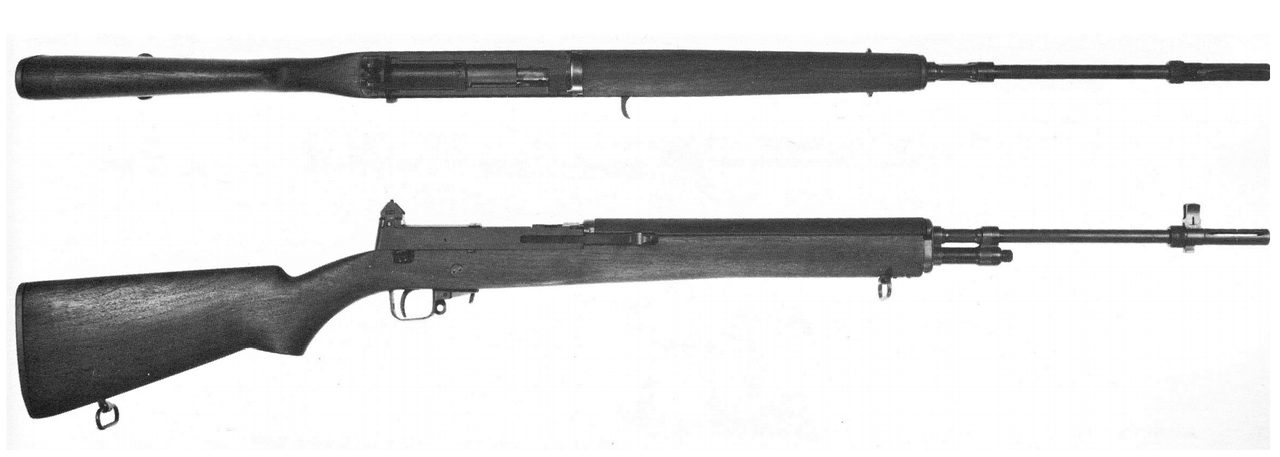

All of the SCHV cartridges in this category were based on the .222 Remington with cases lengthened to meet the Army’s steel helmet perforation requirement while managing the chamber pressure.
.224 Springfield/T65 (.224 Rem Mag) is a 2.280” COL cartridge, so it would have required a slightly larger magazine internal length that would need specs for allowance of tolerance variation in mass production.
In hindsight, they could have exceeded the 500yd steel helmet perforation test by sticking with .222 Rem and putting a sleek secant ogive with boat tail projectile in it, but muzzle velocity would have been reduced if the bullet would have weighed more than the 68gr flat base they were working with initially.
Coming back full circle to the Valkrie, it’s interesting that at least one of the engineers proposed a cartridge based on the .25 Remington but using a more modern Spitzer bullet with a nice boat tail and higher BC. This would give them the case capacity to drive velocity without pushing pressure too crazy, and enough projectile mass to play with the shape to optimize energy retention at 500yds to perforate the steel helmet. He basically proposed a .22-.25 Rem SPC with longer COL in the early 1960s, but it never went anywhere.
The medium rimless cartridge line-up from the turn of the Century included .25 Remington, .30 Remington, and .32 Remington in the Remington Model 8 semi-automatic rifle, (which the AK gets its safety/selector from).
Fast-forward several decades and the case for those cartridges was revived with the 6.8 Remington SPC, a .30 Remington case cut down and necked-down to .277” to fit into the AR-15 magazine well. I really think there was a missed opportunity to go with a .257” bore with that case in the AR-15, and while there are wildcats that do exactly that, none of them are well-known or picked up by any major company.
Remington Model 8s in .25 Rem, .30 Rem, .32 Rem., and .35 Rem (.35 Rem has larger case head of .458”):


So there is quite a history behind the evolution to .224 Valkyrie but for cartridges with different purposes. You would think that the industry would be more receptive to it, but the troubled start of getting it to shoot accurately in AR-15s does not bode well.
If you look at this and many other threads or videos, you’ll see shooters who have bolt guns chambered in it that shoot lights-out, while a lot of the AR-15s just don’t seem to hold a group well in many cases. I know there was extensive effort from JP and other respected shops who invested tens of thousands of dollars trying to get it to shoot consistently with no-joy.
I think one of the biggest problems is trying to set the chamber up for the loaded factory ammo spread from Federal, ranging from the 60gr Nosler Ballistic Tip all the way up to the 90gr SMK. With a conventional freebore, they put the leade in the middle of where it should work ok for all of these bullets, and spec’d the reamer that way.
Then you have the after-market where a laundry list of shops who think they can do it better, with entry-level barrel prices sold en-masse, start cranking out product without having really vetted their process in complying with SAAMI and the bullet requirements of the 90gr SMK in particular.
Those are some sexy Model 8's!Outside of the .30 Carbine wildcats necked down to .224”, there were at least 3 different .224” cartridges associated with the SCHV at the time:
Left: The already established and in-production .222 Remington
Center: The .222 Remington Special prototype cartridge that became .223 Remington and 5.56x45
Right: The T65 .224 Springfield which became the .222 Remington Magnum

Springfield SCHV Infantry Rifle in .224 Springfield


All of the SCHV cartridges in this category were based on the .222 Remington with cases lengthened to meet the Army’s steel helmet perforation requirement while managing the chamber pressure.
.224 Springfield/T65 (.224 Rem Mag) is a 2.280” COL cartridge, so it would have required a slightly larger magazine internal length that would need specs for allowance of tolerance variation in mass production.
In hindsight, they could have exceeded the 500yd steel helmet perforation test by sticking with .222 Rem and putting a sleek secant ogive with boat tail projectile in it, but muzzle velocity would have been reduced if the bullet would have weighed more than the 68gr flat base they were working with initially.
Coming back full circle to the Valkrie, it’s interesting that at least one of the engineers proposed a cartridge based on the .25 Remington but using a more modern Spitzer bullet with a nice boat tail and higher BC. This would give them the case capacity to drive velocity without pushing pressure too crazy, and enough projectile mass to play with the shape to optimize energy retention at 500yds to perforate the steel helmet. He basically proposed a .22-.25 Rem SPC with longer COL in the early 1960s, but it never went anywhere.
The medium rimless cartridge line-up from the turn of the Century included .25 Remington, .30 Remington, and .32 Remington in the Remington Model 8 semi-automatic rifle, (which the AK gets its safety/selector from).
Fast-forward several decades and the case for those cartridges was revived with the 6.8 Remington SPC, a .30 Remington case cut down and necked-down to .277” to fit into the AR-15 magazine well. I really think there was a missed opportunity to go with a .257” bore with that case in the AR-15, and while there are wildcats that do exactly that, none of them are well-known or picked up by any major company.
Remington Model 8s in .25 Rem, .30 Rem, .32 Rem., and .35 Rem (.35 Rem has larger case head of .458”):


So there is quite a history behind the evolution to .224 Valkyrie but for cartridges with different purposes. You would think that the industry would be more receptive to it, but the troubled start of getting it to shoot accurately in AR-15s does not bode well.
If you look at this and many other threads or videos, you’ll see shooters who have bolt guns chambered in it that shoot lights-out, while a lot of the AR-15s just don’t seem to hold a group well in many cases. I know there was extensive effort from JP and other respected shops who invested tens of thousands of dollars trying to get it to shoot consistently with no-joy.
I think one of the biggest problems is trying to set the chamber up for the loaded factory ammo spread from Federal, ranging from the 60gr Nosler Ballistic Tip all the way up to the 90gr SMK. With a conventional freebore, they put the leade in the middle of where it should work ok for all of these bullets, and spec’d the reamer that way.
Then you have the after-market where a laundry list of shops who think they can do it better, with entry-level barrel prices sold en-masse, start cranking out product without having really vetted their process in complying with SAAMI and the bullet requirements of the 90gr SMK in particular.
Yes, very interesting how things come full circle.
Look at the performance of the 6.5x55 and 7x57 and the modern equivalents that are the darlings now.
I always thought the .250-3000 would be a nearly ideal combat rifle cartridge.
FWIW, I built a .22 nosler bolt gun (I had a .223 rem sitting around) with a 7 twist barrel that is very accurate with the 80 grainers, wouldn't shoot the 88 ELDM's worth a shit, and I could push them fairly hard out of that nosler ( I got 3100 fps with the 80's easily). Those damn long for .22 cal bullets seem to be really finicky.
I really like the .250 Savage case as well. Kinda pushes you outside of the AR-15 though with the .473” case head, and steers towards a 2.500” COL cartridge that requires magazines as fat as 7.62 NATO mags, with COL in between 5.56 and 7.62 NATO.
When I run the numbers, does it make itself worthwhile to do all the development of the magazine to reach the performance levels that are midway between any of the current micro and short action cartridges?
When I run the numbers, does it make itself worthwhile to do all the development of the magazine to reach the performance levels that are midway between any of the current micro and short action cartridges?
The juice isn't worth the squeeze anymore. My feeling is this:I really like the .250 Savage case as well. Kinda pushes you outside of the AR-15 though with the .473” case head, and steers towards a 2.500” COL cartridge that requires magazines as fat as 7.62 NATO mags, with COL in between 5.56 and 7.62 NATO.
When I run the numbers, does it make itself worthwhile to do all the development of the magazine to reach the performance levels that are midway between any of the current micro and short action cartridges?
All of the modern guns like the AR are machined on cnc machines. The dimensions can be changed.
Folks always try to fit something in the AR15 platform or the AR10 platform. Maybe the answer is a new platform somewhere in between.
Of course, you could then use the .30 rem case, longer than the spc, shorter than the 7.62x51. Say around 46 mm pushing a 115 grain 6.8 or .25 cal bullet.
So you think he designed it for the 222 magnum and then downsized it to the 223 because the military wanted faster velocities?I'm thinking it was the .222 magnum. Big difference.
No. When did I say that?So you think he designed it for the 222 magnum and then downsized it to the 223 because the military wanted faster velocities?
I was mistaken in regards to the AR15.
However, I was correct that the .222 magnum was under development at the same time, it was for a competing design.
If you would have read further, you would have seen that.
That was my whole statement "he designed it for the 222."No. When did I say that?
I was mistaken in regards to the AR15.
However, I was correct that the .222 magnum was under development at the same time, it was for a competing design.
If you would have read further, you would have seen that.
You said I was wrong that he designed the AR15 for the 222 magnum and there was a big difference.
Everyone knows he designed it for 1 cartridge but the military wanted more velocity so he changed it to the 223(5.56x45) to reach their target velocity.
Last edited:
My Shilen barreled Valkyrie shoots groups like this as well with 90 and 95 SMKs.Did some more load work this morning. My Shilen barrel seems to love the Hornady 88 ELD’s. Five shots at 100 yds.
It’s hard to do it every time, but the potential is there.
When I Chump a shot, my groups open up to 1/2”.
It’s the most accurate gas gun I’ve ever had.
Well, then, you have a problem with comprehension.That was my whole statement "he designed it for the 222."
You said I was wrong that he designed the AR15 for the 222 magnum and there was a big difference.
Everyone knows he designed it for 1 cartridge but the military wanted more velocity so he changed it to the 223(5.56x45) to reach their target velocity.
Re-read my post, I clearly said "I'm thinking".
It was not a declarative statement, it was a statement that I believed (erroneously) but it clearly wasn't a statement of fact.
There IS a tremendous amount of difference between the performance of the .222 and the .223/5.56 and even more so the .222 Magnum.
I know there is a difference and that is why I said the AR15 was originally designed for the 222. I didn't bring up the 222 mag, you did. If you hadn't brought up a cartridge that had nothing to do with the AR15 we wouldn't be having this conversation.Well, then, you have a problem with comprehension.
Re-read my post, I clearly said "I'm thinking".
It was not a declarative statement, it was a statement that I believed (erroneously) but it clearly wasn't a statement of fact.
There IS a tremendous amount of difference between the performance of the .222 and the .223/5.56 and even more so the .222 Magnum.
Again, I've admitted I was wrong in regards to the 222 magnum. what the fuck more do you want, you're the one that keeps harping on it.I know there is a difference and that is why I said the AR15 was originally designed for the 222. I didn't bring up the 222 mag, you did. If you hadn't brought up a cartridge that had nothing to do with the AR15 we wouldn't be having this conversation.
Could you post more details about your build?My Shilen barreled Valkyrie shoots groups like this as well with 90 and 95 SMKs.
It’s hard to do it every time, but the potential is there.
When I Chump a shot, my groups open up to 1/2”.
It’s the most accurate gas gun I’ve ever had.
Receiver set
Barrel
Extension
Twist rate
Barrel length
Gas system length
Who chambered it and with what reamer
Gas block type and fitting method
BCG
Stock/spring/buffer
FCG
Optic Mount
Optic
Answer me this, maybe I'm still new to shooting and just don't understand.
My Tikka (1:8 twist) chambered in 223 with factory 75GR PPU Match ammo did .74 MOA @ 100. As I am slowly buying stuff for reloading hoping to get that even smaller but for "cheap" ammo did pretty good. Why cant the valkyrie do the same with the same bullet/ twist?
Why does the Valkyrie have a problem stabilizing bullets, Why is it super jump sensitive, and why are people pushing the twist rates so fast for a little bullet; Wont these 1:6xx Twist just RPM the jacket right off?
Some of the Palma shooters take the 80GR 223 and shoot 1000 yards in comp with 1:7 twist. why doesn't 1:7 work with the Valkyrie
I wanna make a 224V in a bolt gun but with all these problems I dont want to
My Tikka (1:8 twist) chambered in 223 with factory 75GR PPU Match ammo did .74 MOA @ 100. As I am slowly buying stuff for reloading hoping to get that even smaller but for "cheap" ammo did pretty good. Why cant the valkyrie do the same with the same bullet/ twist?
Why does the Valkyrie have a problem stabilizing bullets, Why is it super jump sensitive, and why are people pushing the twist rates so fast for a little bullet; Wont these 1:6xx Twist just RPM the jacket right off?
Some of the Palma shooters take the 80GR 223 and shoot 1000 yards in comp with 1:7 twist. why doesn't 1:7 work with the Valkyrie
I wanna make a 224V in a bolt gun but with all these problems I dont want to
Last edited:
An 8 twist will stabilize up to an 80gr ELD if the muzzle vel is around 2900. I've heard the new 85 Berger will also stabilize.Answer me this, maybe I'm still new to shooting and just don't understand.
My Tikka (1:8 twist) chambered in 223 with factory 75GR PPU Match ammo did .74 MOA @ 100. As I am slowly buying stuff for reloading hoping to get that even smaller but for "cheap" ammo did pretty good. Why cant the valkyrie do the same with the same bullet/ twist?
Why does the Valkyrie have a problem stabilizing bullets, Why is it super jump sensitive, and why are people pushing the twist rates so fast for a little bullet; Wont these 1:6xx Twist just RPM the jacket right off?
Some of the Palma shooters take the 80GR 223 and shoot 1000 yards in comp with 1:7 twist. why doesn't 1:7 work with the Valkyrie
I wanna make a 224V in a bolt gun but with all these problems I dont want to
The 7 twist will work in a Valk unless you try to shoot the 95 SMK. Button rifled barrels twist rate is not perfect some may be 6.75 and some may be 7.25 that could be why some 7 twist barrels work and some do not.
You have to find the sweet spot for jump for each bullet, some like to be jammed, some shoot at .010-.020 off and some shoot fine at .050-.060 off.
Not many bullets will come apart these days, the thin jackets on the Bergers were fixed 20 years ago. I have some 75gr Amax that would come apart over 3000fps but I think that was due to the tip and now Hornady has fixed that. I've run 30gr VG up to 4400 and 40gr vmax over 3800 in a 6.5 twist and they didn't come apart.
Lastly I believe some of the problems were due to reamers, some cut good chambers and some did not.
That’s a bunch.Could you post more details about your build?
Receiver set
Barrel
Extension
Twist rate
Barrel length
Gas system length
Who chambered it and with what reamer
Gas block type and fitting method
BCG
Stock/spring/buffer
FCG
Optic Mount
Optic
Standard receiver squared
S&W lower
Jared trigger.
Shilen 6-5 twist Ultra match. 24” long .875 DIA
D tech chamber
Rifle gas standard block
Adjustable gas key on a basic bolt carrier head spaced bolt.
JP silent spring
Mag pul PRS stock
S&B 5-25 Police marksman. Burris rings.
Thunder Beast 30 cal direct thread.
Most 6.8 mags are decent.What magazines do you recommend for the 224 V?
Barrett good if loading to 2.28" OAL is OK
ASC and CPD will allow loading to 2.295" if you need to load the 80 and 88 ELDs longer.
PRI are very sturdy and also allow loading to 2.295 but $40+
It takes a barrel, bolt and mag, same as a 6mmARC except the 6.8/Valk bolts are stronger and mags feed better.
If you want a successful Valkyrie it is easier to forget the 90 and 95smk. Shoot the 80gr ELD using H4895 at 3000fps, it will outperform the heavier bullets in drop and drift. The heavier bullets even though they have higher BCs will never catch up to the 80 eld at 3000 unless you really plan on shooting past 1000yds..
20" 1:7 .224 Valkyrie 10 rds @ 25 yds.
Hornady 75gr ELD Match #22791
27.0 gr. Hodgdon CFE 223
Last edited:
I'm not real sure the valkyrie is dead . I have been seeing more of them show up at prs gas gun matches . It seem's the 75 grain eldm is pretty popular with those guy's . Me myself I use my valkyrie for deer hunting and shoot 90 grain federal fusions with great result's . I'm using a 20 inch 6.5 twist barrel .
Now that the 22 arc is out, fair to say the Valk is is more dead than it was last week.I'm not real sure the valkyrie is dead . I have been seeing more of them show up at prs gas gun matches . It seem's the 75 grain eldm is pretty popular with those guy's . Me myself I use my valkyrie for deer hunting and shoot 90 grain federal fusions with great result's . I'm using a 20 inch 6.5 twist barrel .
Similar threads
- Replies
- 1
- Views
- 854
- Replies
- 2
- Views
- 755
- Replies
- 56
- Views
- 5K
- Replies
- 2
- Views
- 895
- Replies
- 4
- Views
- 1K
